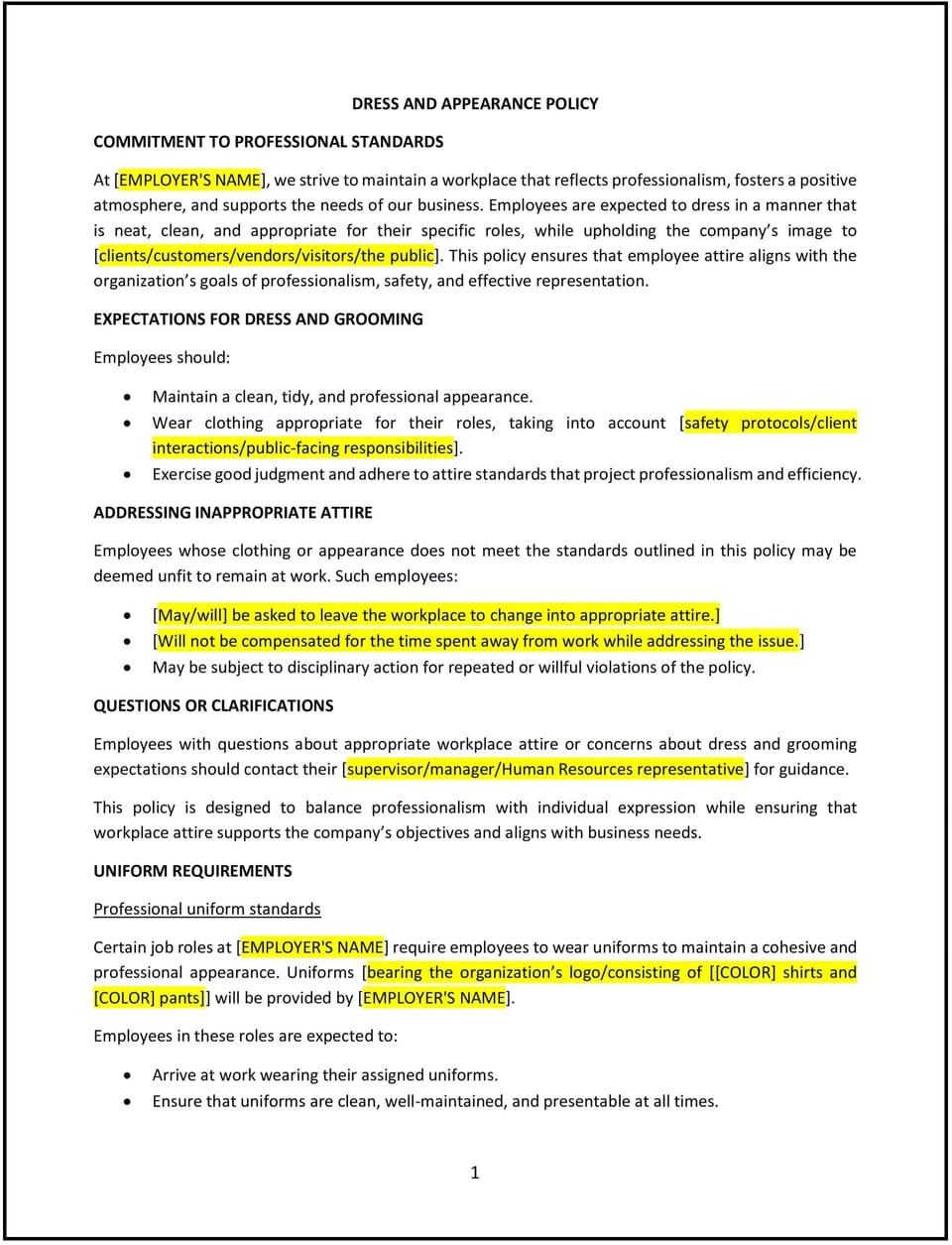Dress and appearance policy (Maryland): Free template

Dress and appearance policy (Maryland)
This dress and appearance policy is designed to help Maryland businesses set clear expectations for workplace attire while accommodating industry standards, safety requirements, and employee comfort. It provides guidelines to promote professionalism while respecting diversity and inclusion.
By adopting this policy, Maryland businesses can maintain a professional work environment, ensure safety, and align with community standards.
How to use this dress and appearance policy (Maryland)
- Define dress code standards: Specify the acceptable attire for various roles or settings, such as business formal, business casual, or uniforms.
- Address industry-specific requirements: Include guidelines for sectors that require protective gear, uniforms, or specific safety attire.
- Promote inclusivity: Allow accommodations for cultural, religious, or medical needs, such as head coverings or adaptive clothing.
- Establish grooming expectations: Outline standards for hygiene and grooming that align with the business’s professional image.
- Provide casual day guidelines: If applicable, specify acceptable attire for casual days or special events.
- Include disciplinary measures: Clearly state the consequences for failing to adhere to the policy, such as verbal warnings or additional training.
- Reflect Maryland-specific considerations: Align the policy with Maryland laws, such as those protecting employees from discrimination based on cultural or religious attire.
Benefits of using this dress and appearance policy (Maryland)
Implementing this policy provides Maryland businesses with several advantages:
- Promotes professionalism: Creates a consistent and polished image for employees representing the business.
- Enhances safety: Ensures employees adhere to attire requirements that comply with safety regulations.
- Encourages inclusivity: Accommodates diverse needs while maintaining workplace standards.
- Reduces misunderstandings: Establishes clear expectations for employees and managers.
- Reflects company culture: Aligns dress code guidelines with the organization’s values and industry norms.
Tips for using this dress and appearance policy (Maryland)
- Communicate expectations: Share the policy during onboarding and provide regular reminders about dress code standards.
- Train managers: Ensure supervisors are equipped to enforce the policy fairly and consistently.
- Allow flexibility: Be open to addressing employee concerns or accommodating special requests related to attire.
- Review regularly: Update the policy as workplace norms or Maryland laws evolve.
- Balance professionalism and comfort: Consider both practicality and the company’s professional image when setting guidelines.
Q: What types of attire are typically required under a dress code policy?
A: Dress code requirements depend on the workplace and may include business formal, business casual, or specific uniforms based on industry standards.
Q: How should businesses handle accommodations for religious or cultural attire?
A: Businesses should provide reasonable accommodations for religious or cultural attire unless it poses a safety concern or undue hardship.
Q: Are employees allowed to dress casually on certain days?
A: Businesses may designate casual days and specify acceptable attire for those occasions in the policy.
Q: What should businesses do if an employee violates the dress code?
A: Employers should address violations respectfully, starting with a discussion or verbal warning, and escalate if necessary as outlined in the policy.
Q: Are Maryland businesses required to allow protective hairstyles or cultural attire?
A: Yes, Maryland law protects employees from discrimination based on hairstyles, religious, or cultural attire.
Q: How often should this policy be reviewed?
A: The policy should be reviewed annually or when workplace norms or Maryland legal standards change.
Q: Can businesses require uniforms for certain roles?
A: Yes, uniforms may be required for roles where consistent appearance, branding, or safety considerations are necessary.
This article contains general legal information and does not contain legal advice. Cobrief is not a law firm or a substitute for an attorney or law firm. The law is complex and changes often. For legal advice, please ask a lawyer.


